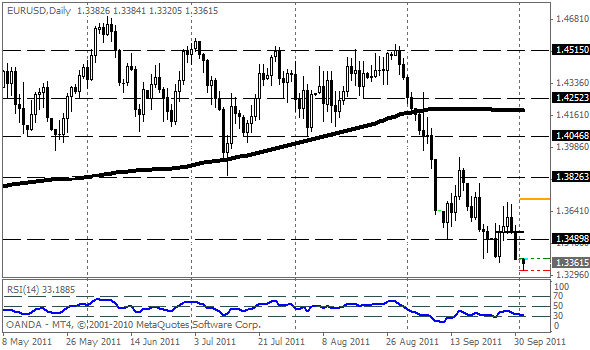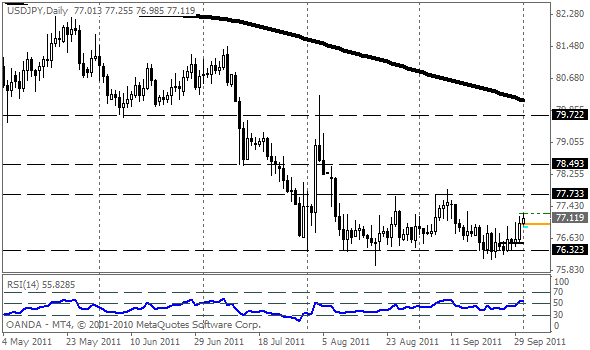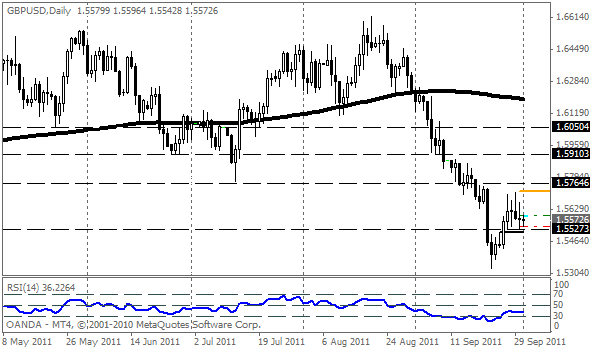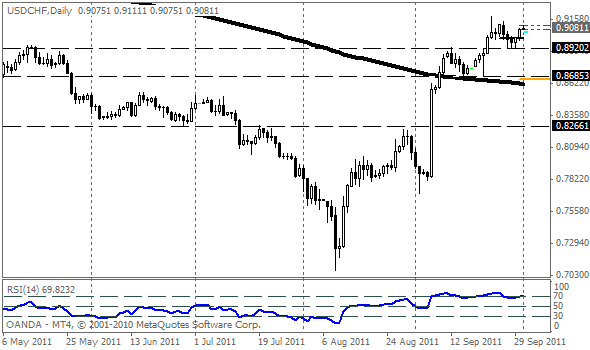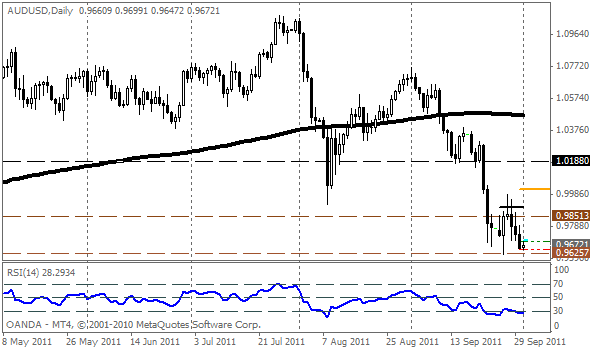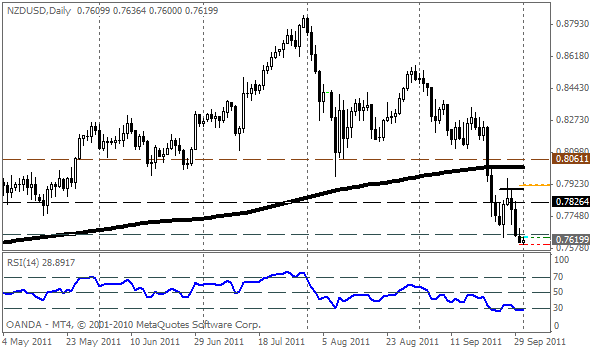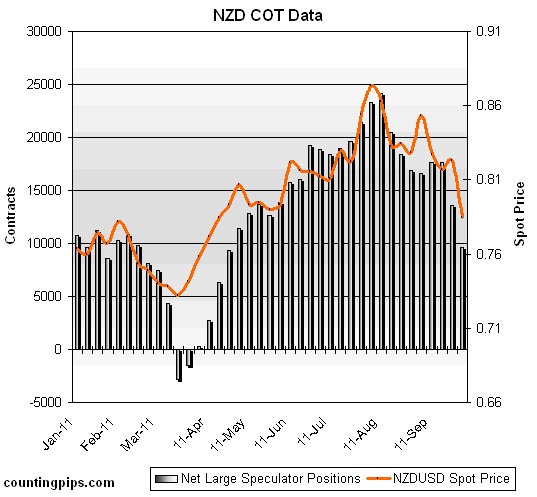Fundamental Forex Market Outlook for the Upcoming Week
The key fundamental economic events that can strongly influence the forex market this week feature the U.S. Non-Farm Payrolls data (51K) due out on Friday and the RBA, BOE, ECB and BOJ rate decisions scheduled for this week. Additional key economic releases due out this week are detailed further below, with the current market consensus expectations or the last result included in parenthesis whenever available.
Monday’s economic data features the results of the Japanese Tankan Manufacturing Index (2), Swiss Retail Sales (4.5%), UK Manufacturing PMI (48.9), U.S. ISM  Manufacturing PMI (50.5), and New Zealand’s NZIER Business Confidence (last 27).
Manufacturing PMI (50.5), and New Zealand’s NZIER Business Confidence (last 27).
Tuesday’s key data includes Aussie Building Approvals (1.1%), Trade Balance (2.14B) and RBA Rate Decision (4.75%), plus UK Halifax HPI (Oct 4th-7th, last -1.2%), UK Construction PMI (51.7), plus a speech by ECB President Trichet and testimony by Fed Chairman Bernanke.
On Wednesday, the market will closely monitor Aussie Retail Sales (0.3%), the UK Current Account (-10.4B) and Services PMI (50.7), plus the key U.S. numbers that include ADP Non-Farm Employment Change (76K) and ISM Non-Manufacturing PMI (53.1).
Thursday will see the release of the BOE’s Rate Decision (0.5%) and Asset Purchase Facility (200B), the ECB’s Rate Decision (1.50%) and Press Conference, Canadian Building Permits (0.6%) and Ivey PMI (58.2), plus U.S. Weekly Initial Jobless Claims (411K) and Pending Home Sales (-1.6).
Friday’s schedule features this week’s highlighted U.S. Non-Farm Payrolls (51K) and Unemployment Rate (9.1%) data, as well as the tentatively scheduled BOJ Rate Decision (<0.10%) and Press Conference, UK PPI Input (1.4%), and the Canadian Employment Change (19.6K) and Unemployment Rate (7.3%).
Technical Forex Market Outlook for the Upcoming Week
EUR/USD:
Weekly Forecast: Lower
Resistance: 1.3362, 1.3384, 1.3494, 1.3566, 1.3586, 1.3689, 1.3720, 1.3743, 1.3796, 1.3936, 1.3972, 1.4103, 1.4147, 1.4258, 1.4279, 1.4327 and 1.4499/1.4503.
Support: 1.3333, 1.3244, 1.3055, 1.3000, 1.2968, 1.2873, 1.2733, 1.2643 and 1.2586.
200-day MA: 1.4054 and slowly rising.
14-day RSI: 30.4 and falling.
USD/JPY:
Weekly Forecast: Somewhat higher.
Resistance: 77.19, 77.30/37, 77.71, 77.85, 78.02, 78.66, 79.05, 79.40, 80.00, 80.22, 80.82, 81.34, 81.76, 82.01/22, 82.77, 83.09 and 83.77.
Support: 77.01, 76.88/96, 76.69, 76.56, 76.32, 76.25, 76.14, 76.10, 75.94, 75.00 and 70.00.
200-day MA: 80.43 and falling.
14-day RSI: 53.0 and rising.
GBP/USD:
Weekly Forecast: Higher
Resistance: 1.5632, 1.5664, 1.5685, 1.5705, 1.5714, 1.5745, 1.5839, 1.5867, 1.5883, 1.5912/19, 1.5951, 1.6000, 1.6037, 1.6081, 1.6130, 1.6204/06 and 1.6252/59.
Support: 1.5531, 1.5483, 1.5422, 1.5373, 1.5343/55, 1.5326, 1.5293, 1.5123, 1.5000, 1.4947, 1.4872, 1.4785/97, 1.4500, 1.4474, 1.4345 and 1.4229.
200-day MA: 1.6128 and rising mildly.
14-day RSI: 37.4 and rising.
USD/CHF:
Weekly Forecast: Somewhat higher.
Resistance: 0.9180, 0.9294, 0.9300, 0.9327, 0.9339, 0.9368, 0.9774/83, 0.9971, 0.9997, 1.0000 and 1.0065.
Support: 0.9000, 0.8994, 0.8979, 0.8916/26, 0.8883, 0.8873, 0.8797, 0.8788, 0.8728, 0.8646, 0.8622, 0.8536, 0.8239 and 0.8000.
200-day MA: 0.8790 and falling mildly.
14-day RSI: 69.7 and flat.
AUD/USD:
Weekly Forecast: Somewhat higher
Resistance: 0.9700/04, 0.9731, 0.9803, 0.9842/64, 1.0000, 1.0077, 1.0146, 1.0176, 1.0296, 1.0310, 1.0347, 1.0360, 1.0373/96, 1.0473, 1.0481, and 1.0511.
Support: 0.9689, 0.9667, 0.9651, 0.9620, 0.9536/41, 0.9500, 0.9462, 0.9330, 0.9220, 0.9077, 0.9000, 0.8870, 0.8858, 0.8632, 0.8550 and 0.8066/81.
200-day MA: 1.0387 and falling mildly.
14-day RSI: 29.2 oversold and falling.
USD/CAD:
Weekly Forecast: Somewhat lower
Resistance: 1.0490, 1.0500, 1.0506, 1.0646, 1.0669, 1.0742, 1.0756, 1.0785, 1.0853, 1.0868, 1.1000, and 1.1101/23.
Support: 1.0372/84, 1.0347/56, 1.0322, 1.0360, 1.0255, 1.0236, 1.0208, 1.0139, 1.0088, 1.0057, and 0.9939/1.0030.
200-day MA: 0.9784 and rising mildly.
14-day RSI: 74.6 overbought and rising.
NZD/USD:
Weekly Forecast: Somewhat higher
Resistance: 0.7635, 0.7654/65, 0.7716, 0.7750/54, .07816, 0.7851, 0.7892, 0.7950/62, 0.8000/44 and 0.8060/93.
Support: 0.7605, 0.7549, 0.7523, 0.7504, 0.7500, 0.7453, 0.7426, 0.7404, 0.7342, 0.7321, 0.7189, 0.7115, 0.7000 and 0.6945/62.
200-day MA: 0.7956 and rising.
14-day RSI: 27.4 oversold and falling.
